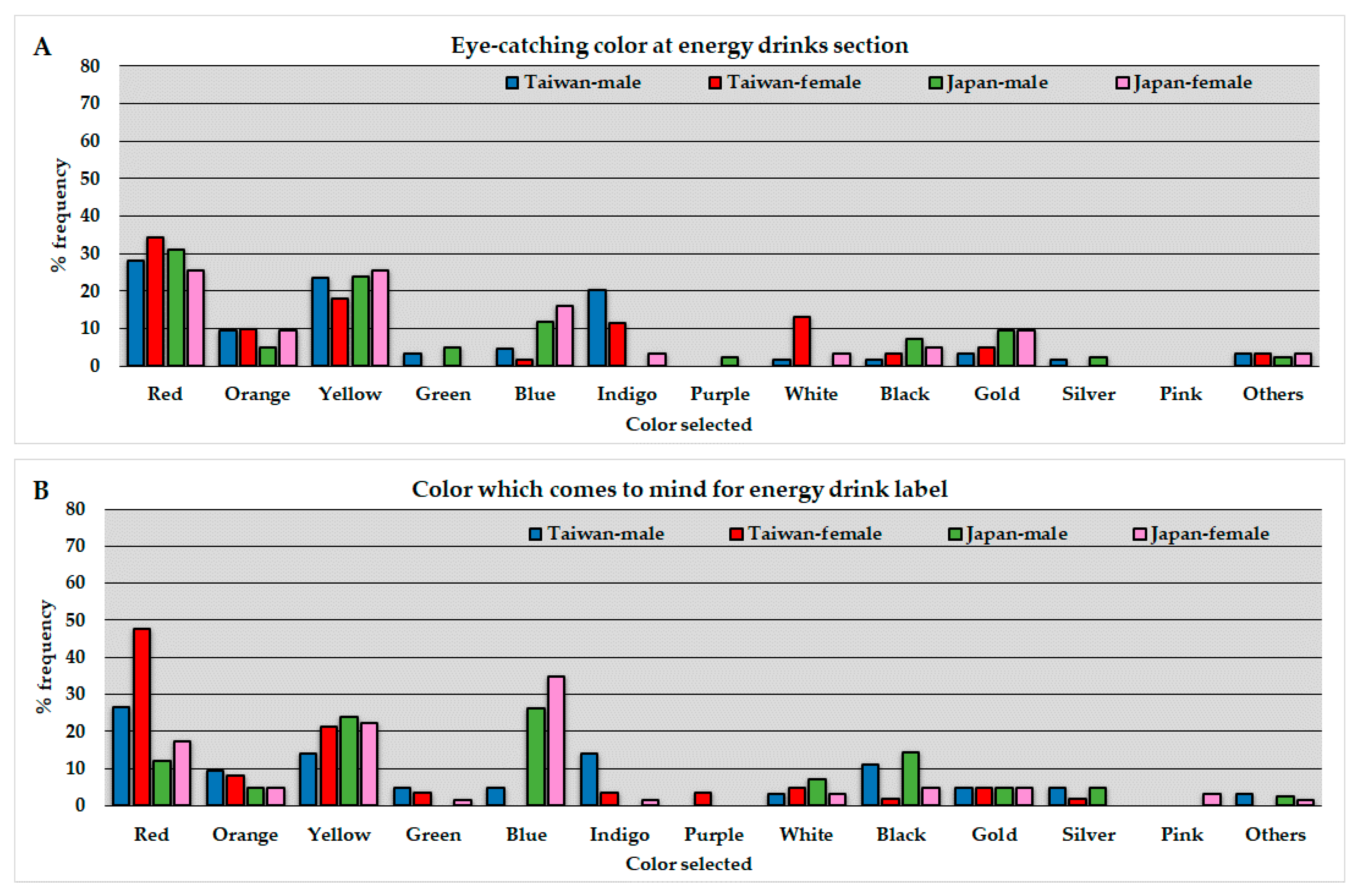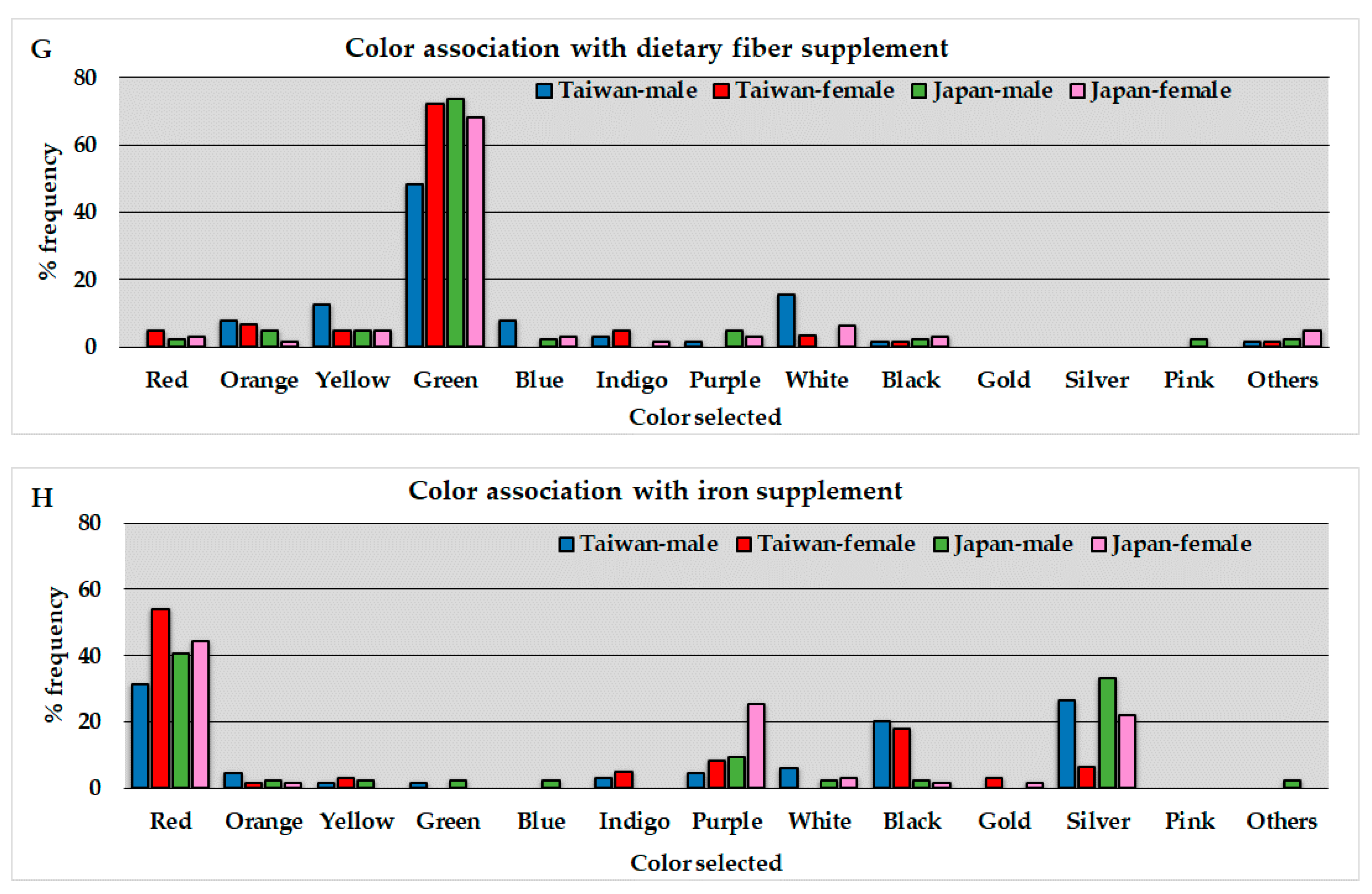Country and Gender Differences in the Color Association with Energy Drinks: A Survey in Taiwanese and Japanese Students
Abstract
1. Introduction
2. Materials and Methods
2.1. Study Design and Respondents
2.2. Statistical Analyses
3. Results
4. Discussion
5. Conclusions
Author Contributions
Funding
Acknowledgments
Conflicts of Interest
Ethics Statements
References
- Somers, K.R.; Svatikova, A. Cardiovascular and Autonomic Responses to Energy Drinks-Clinical Implications. J. Clin. Med. 2020, 9, 431. [Google Scholar] [CrossRef] [PubMed]
- Schaffer, S.W.; Jong, C.J.; Ramila, K.C.; Azuma, J. Physiological roles of taurine in heart and muscle. J. Biomed. Sci. 2010, 17 (Suppl. 1), S2. [Google Scholar] [CrossRef] [PubMed]
- Pettenuzzo, L.F.; Noschang, C.; von Pozzer Toigo, E.; Fachin, A.; Vendite, D.; Dalmaz, C. Effects of chronic administration of caffeine and stress on feeding behavior of rats. Physiol. Behav. 2008, 95, 295–301. [Google Scholar] [CrossRef] [PubMed]
- Tardy, A.L.; Pouteau, E.; Marquez, D.; Yilmaz, C.; Scholey, A. Vitamins and Minerals for Energy, Fatigue and Cognition: A Narrative Review of the Biochemical and Clinical Evidence. Nutrients 2020, 12, 228. [Google Scholar] [CrossRef] [PubMed]
- Sorushanova, A.; Delgado, L.M.; Wu, Z.; Shologu, N.; Kshirsagar, A.; Raghunath, R.; Mullen, A.M.; Bayon, Y.; Pandit, A.; Raghunath, M.; et al. The Collagen Suprafamily: From Biosynthesis to Advanced Biomaterial Development. Adv. Mater. 2019, 31, e1801651. [Google Scholar] [CrossRef]
- Avila Rodríguez, M.I.; Rodríguez Barroso, L.G.; Sánchez, M.L. Collagen: A review on its sources and potential cosmetic applications. J. Cosmet. Dermatol. 2018, 17, 20–26. [Google Scholar] [CrossRef]
- Papathanasopoulos, A.; Camilleri, M. Dietary fiber supplements: Effects in obesity and metabolic syndrome and relationship to gastrointestinal functions. Gastroenterology 2010, 138, 65–72.e2. [Google Scholar] [CrossRef]
- Camaschella, C. Iron-deficiency anemia. N. Engl. J. Med. 2015, 372, 1832–1843. [Google Scholar] [CrossRef]
- De Sanctis, V.; Soliman, N.; Soliman, A.T.; Elsedfy, H.; Di Maio, S.; El Kholy, M.; Fiscina, B. Caffeinated energy drink consumption among adolescents and potential health consequences associated with their use: A significant public health hazard. Acta Biomed. 2017, 88, 222–231. [Google Scholar] [CrossRef]
- Wolk, B.J.; Ganetsky, M.; Babu, K.M. Toxicity of energy drinks. Curr. Opin. Pediatr. 2012, 24, 243–251. [Google Scholar] [CrossRef]
- Malinauskas, B.M.; Aeby, V.G.; Overton, R.F.; Carpenter-Aeby, T.; Barber-Heidal, K. A survey of energy drink consumption patterns among college students. Nutr. J. 2007, 6, 35. [Google Scholar] [CrossRef] [PubMed]
- Seifert, S.M.; Schaechter, J.L.; Hershorin, E.R.; Lipshultz, S.E. Health effects of energy drinks on children, adolescents, and young adults. Pediatrics 2011, 127, 511–528. [Google Scholar] [CrossRef] [PubMed]
- Temple, J.L.; Bernard, C.; Lipshultz, S.E.; Czachor, J.D.; Westphal, J.A.; Mestre, M.A. The Safety of Ingested Caffeine: A Comprehensive Review. Front. Psychiatry 2017, 8, 80. [Google Scholar] [CrossRef] [PubMed]
- Boon, H.; Bozinovski, N. A Systematic Narrative Review of the Evidence for Labeling of Natural Health Products and Dietary Supplements. J. Altern. Complement. Med. 2019, 25, 777–788. [Google Scholar] [CrossRef] [PubMed]
- Schuldt, J.P. Does green mean healthy? Nutrition label color affects perceptions of healthfulness. Health Commun. 2013, 28, 814–821. [Google Scholar] [CrossRef] [PubMed]
- Costa, B.M.; Hayley, A.; Miller, P. Young adolescents’ perceptions, patterns, and contexts of energy drink use. A focus group study. Appetite 2014, 80, 183–189. [Google Scholar] [CrossRef]
- Elliot, A.J.; Maier, M.A. Color psychology: Effects of perceiving color on psychological functioning in humans. Annu. Rev. Psychol. 2014, 65, 95–120. [Google Scholar] [CrossRef]
- Hoppu, U.; Puputti, S.; Aisala, H.; Laaksonen, O.; Sandell, M. Individual Differences in the Perception of Color Solutions. Foods 2018, 7, 154. [Google Scholar] [CrossRef]
- Saito, M. A comparative study of color preferences in Japan, China and Indonesia, with emphasis on the preference for white. Percept. Mot. Skills 1996, 83, 115–128. [Google Scholar] [CrossRef]
- Cohen Hubal, E.A.; de Wet, T.; Du Toit, L.; Firestone, M.P.; Ruchirawat, M.; van Engelen, J.; Vickers, C. Identifying important life stages for monitoring and assessing risks from exposures to environmental contaminants: Results of a World Health Organization review. Regul. Toxicol. Pharmacol. 2014, 69, 113–124. [Google Scholar] [CrossRef]
- Kacanek, D.; Huo, Y.; Malee, K.; Mellins, C.A.; Smith, R.; Garvie, P.A.; Tassiopoulos, K.; Lee, S.; Berman, C.A.; Paul, M.; et al. Nonadherence and unsuppressed viral load across adolescence among US youth with perinatally acquired HIV. AIDS 2019, 33, 1923–1934. [Google Scholar] [CrossRef] [PubMed]
- Kanda, Y. Investigation of the freely available easy-to-use software ‘EZR’ for medical statistics. Bone Marrow Transplant. 2013, 48, 452–458. [Google Scholar] [CrossRef] [PubMed]
- Elliot, A.J. Color and psychological functioning: A review of theoretical and empirical work. Front. Psychol. 2015, 6, 368. [Google Scholar] [CrossRef] [PubMed]
- Tham, D.S.Y.; Sowden, P.T.; Grandison, A.; Franklin, A.; Lee, A.K.W.; Ng, M.; Park, J.; Pang, W.; Zhao, J. A systematic investigation of conceptual color associations. J. Exp. Psychol. Gen. 2020, 149, 1311–1332. [Google Scholar] [CrossRef] [PubMed]
- Taylor, C.; Franklin, A. The relationship between color-object associations and color preference: Further investigation of ecological valence theory. Psychon. Bull. Rev. 2012, 19, 190–197. [Google Scholar] [CrossRef] [PubMed]
- Lattimer, J.M.; Haub, M.D. Effects of dietary fiber and its components on metabolic health. Nutrients 2010, 2, 1266–1289. [Google Scholar] [CrossRef]
- Briguglio, M.; Hrelia, S.; Malaguti, M.; Lombardi, G.; Riso, P.; Porrini, M.; Perazzo, P.; Banfi, G. The Central Role of Iron in Human Nutrition: From Folk to Contemporary Medicine. Nutrients 2020, 12, 1761. [Google Scholar] [CrossRef]
- Percy, L.; Mansour, D.; Fraser, I. Iron deficiency and iron deficiency anaemia in women. Best Pract. Res. Clin. Obstet. Gynaecol. 2017, 40, 55–67. [Google Scholar] [CrossRef]
- Al-Shaar, L.; Vercammen, K.; Lu, C.; Richardson, S.; Tamez, M.; Mattei, J. Health Effects and Public Health Concerns of Energy Drink Consumption in the United States: A Mini-Review. Front. Public Health 2017, 5, 225. [Google Scholar] [CrossRef]
- Ehlers, A.; Marakis, G.; Lampen, A.; Hirsch-Ernst, K.I. Risk assessment of energy drinks with focus on cardiovascular parameters and energy drink consumption in Europe. Food Chem. Toxicol. 2019, 130, 109–121. [Google Scholar] [CrossRef]
- Van Dam, R.M.; Hu, F.B.; Willett, W.C. Coffee, Caffeine, and Health. N. Engl. J. Med. 2020, 383, 369–378. [Google Scholar] [CrossRef] [PubMed]
- Subaiea, G.M.; Altebainawi, A.F.; Alshammari, T.M. Energy drinks and population health: Consumption pattern and adverse effects among Saudi population. BMC Public Health 2019, 19, 1539. [Google Scholar] [CrossRef] [PubMed]
- Reissig, C.J.; Strain, E.C.; Griffiths, R.R. Caffeinated energy drinks—A growing problem. Drug Alcohol Depend. 2009, 99, 1–10. [Google Scholar] [CrossRef] [PubMed]
- Breda, J.J.; Whiting, S.H.; Encarnação, R.; Norberg, S.; Jones, R.; Reinap, M.; Jewell, J. Energy drink consumption in europe: A review of the risks, adverse health effects, and policy options to respond. Front. Public Health 2014, 2, 134. [Google Scholar] [CrossRef] [PubMed]
- Peacock, A.; Droste, N.; Pennay, A.; Miller, P.; Lubman, D.I.; Bruno, R. Awareness of energy drink intake guidelines and associated consumption practices: A cross-sectional study. BMC Public Health 2016, 16, 6. [Google Scholar] [CrossRef] [PubMed]
- Bedi, N.; Dewan, P.; Gupta, P. Energy drinks: Potions of illusion. Indian Pediatr. 2014, 51, 529–533. [Google Scholar] [CrossRef] [PubMed]



| Variables | Taiwanese | Japanese | P Value |
|---|---|---|---|
| Total number | 125 | 105 | |
| Male | 64 (51.2%) | 42 (40.0%) | |
| Female | 61 (48.8%) | 63 (60.0%) | |
| Age (years old) | |||
| Male | 20.2 ± 2.0 | 19.7 ± 1.3 | 0.119 |
| Female | 20.3 ± 1.6 | 19.6 ± 2.2 | 0.05 |
| Height (cm) | |||
| Male | 173.5 ± 5.6 | 173.7 ± 6.4 | 0.864 |
| Female | 160.8 ± 4.7 | 158.9 ± 6.1 | 0.055 |
| Weight (kg) | |||
| Male | 67.7± 12.3 | 65.4 ± 9.7 | 0.316 |
| Female | 53.4 ± 7.5 | 51.4 ± 6.4 | 0.142 |
| Male | Female | |
|---|---|---|
| Q1 (Eye catching colors) | ☆ Indigo; P = 0.001, T #:20%, J ##:0% | Blue; P = 0.009, T:2%, J:16% |
| Q2 (Colors for Label) | ☆ Blue: P = 0.002, T:5%, J:26% Indigo; P = 0.001, T:14%, J:0% |
|
| Q3 (Nutrients) | ☆ Yellow; P = 0.005, T:64%, J:36% | Red; P = 0.030, T:3%, J:16% ☆ Yellow; P = 0.001, T:75%, J:33% Blue; P = 0.028, T:0%, J:10% |
| Q4 (Stimulants) | Blue; P <0.001, T:0%, J:19% Others; P = 0.047, T:16%, J:2% | Blue; P = 0.006, T:0%, J:13% |
| Q5 (Cosmetics) | Blue; P = 0.023, T:0%, J:10%
| Red; P = 0.003, T:0%, J:14%
|
| Q6 (Vitamins) | ☆ Yellow; P < 0.001, T:30%, J:64% | ☆ Yellow; P = 0.001, T:44%, J:75% |
| Q7 (Dietary fibers) | ☆ Green; P = 0.015, T:48%, J:74% White; P = 0.006, T:16%, J:0% | |
| Q8 (Iron) | ☆ Black; P = 0.008, T:20%, J:2% | ☆ Purple; P = 0.016, T:8%, J:25% Black; P = 0.002, T:18%, J:2% ☆ Silver; P = 0.020, T:7%, J:22% |
| Taiwanese | Japanese | |
|---|---|---|
| Q1 (Eye catching colors) | White; P = 0.015, M #:2%, F ##:13% | |
| Q2 (Colors for Label) | ☆ Red; P = 0.017, M:27%, F:48% | |
| Q3 (Nutrients) | ||
| Q4 (Stimulants) | ☆ Red; P = 0.013, M:5%, F:20% | |
| Q5 (Cosmetics) | Red; P = 0.006, M:13%, F:0% Pink; P = 0.001, M:0%, F:15% | |
| Q6 (Vitamins) | ||
| Q7 (Dietary fibers) | ☆ Green; P = 0.010, M:48%, F:72% White; P = 0.030, M:16%, F:3% | |
| Q8 (Iron) |
| ☆ Purple; P = 0.047, M:10%, F:25% |
Publisher’s Note: MDPI stays neutral with regard to jurisdictional claims in published maps and institutional affiliations. |
© 2020 by the authors. Licensee MDPI, Basel, Switzerland. This article is an open access article distributed under the terms and conditions of the Creative Commons Attribution (CC BY) license (http://creativecommons.org/licenses/by/4.0/).
Share and Cite
Tanei, S.; Chu, W.-T.; Okamura, T.; Chen, F.-S.; Nagakura, Y. Country and Gender Differences in the Color Association with Energy Drinks: A Survey in Taiwanese and Japanese Students. Foods 2020, 9, 1670. https://doi.org/10.3390/foods9111670
Tanei S, Chu W-T, Okamura T, Chen F-S, Nagakura Y. Country and Gender Differences in the Color Association with Energy Drinks: A Survey in Taiwanese and Japanese Students. Foods. 2020; 9(11):1670. https://doi.org/10.3390/foods9111670
Chicago/Turabian StyleTanei, Shigeharu, Wen-Tseng Chu, Toshimitsu Okamura, Fu-Shih Chen, and Yukinori Nagakura. 2020. "Country and Gender Differences in the Color Association with Energy Drinks: A Survey in Taiwanese and Japanese Students" Foods 9, no. 11: 1670. https://doi.org/10.3390/foods9111670
APA StyleTanei, S., Chu, W.-T., Okamura, T., Chen, F.-S., & Nagakura, Y. (2020). Country and Gender Differences in the Color Association with Energy Drinks: A Survey in Taiwanese and Japanese Students. Foods, 9(11), 1670. https://doi.org/10.3390/foods9111670






